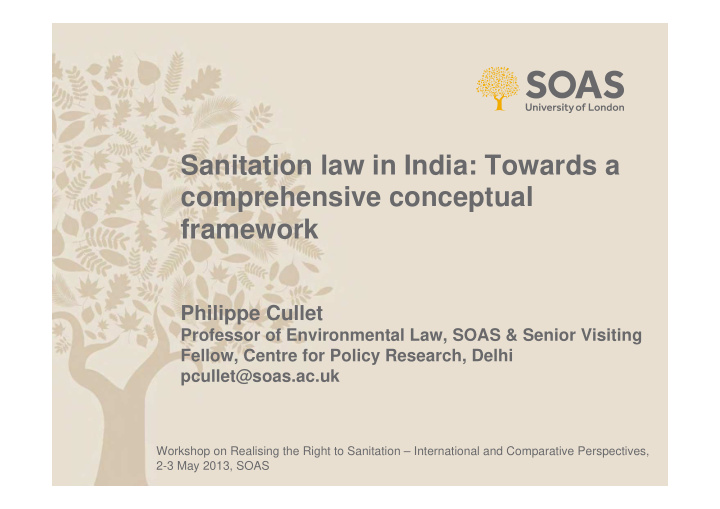



Sanitation law in India: Towards a comprehensive conceptual framework Philippe Cullet Professor of Environmental Law, SOAS & Senior Visiting Fellow, Centre for Policy Research, Delhi pcullet@soas.ac.uk Workshop on Realising the Right to Sanitation – International and Comparative Perspectives, 2-3 May 2013, SOAS
Sanitation in India – Background • Toilets: 814 million people without access, 626 million practising open defecation (59 % of worldwide figure) • Sewerage: 30% urban households have access to sewerage system • Wastewater: 37% let into environment without any treatment • Water pollution: 60% cause by sewage • Health: 21% of communicable diseases in India are water related. • Dry latrines: 700’000 manual scavengers 2
Sanitation – Definition • Expanding definition over time: Sanitation includes personal hygiene, home sanitation, safe water, garbage disposal, excreta disposal and waste water disposal (Nirmal Bharat Abhiyan, 2012). • ‘Expanded’ definition still focuses largely on water dimension of sanitation. Confirmed, eg by policy framework proposing to give priority to Gram Panchayats having functional piped water supply. • Other issues, such as manual scavenging or sanitation workers often treated separately • Violence against women linked to open defecation not necessarily considered as a ‘sanitation’ issue but only as a criminal offence 3
Fundamental right to sanitation • No right to sanitation in the Constitution • Judicial interventions since the early 1980s leading to specific recognition of a fundamental right to sanitation • Virendra Gaur v State of Haryana , 1994: the Supreme Court while debating Haryana’s Town Planning Scheme in a case concerning a proposed land-use change for an area earmarked for open spaces: 1) linked the right to life with human dignity 2) linked sanitation with pollution free water and air and the broader protection of the environment. 4
Other sanitation-related fundamental rights • eg Art. 17 Constitution: ‘Untouchability’ is abolished and its practice in any form is forbidden. The enforcement of any disability arising out of ‘Untouchability’ shall be an offence punishable in accordance with law. • Complemented by: Employment of Manual Scavengers and Construction of Dry Latrines (Prohibition) Act, 1993 2003-onwards: Litigation in Supreme Court 2012: bill to amend the 1993 legislation • Related activities: eg: Manual cleaning of septic tanks 5
Sanitation law - Framework • Powers with regard to sanitation: Primarily states and local bodies (municipalities and panchayats) No state (or national) framework legislation on sanitation Local laws tend to focus on drainage and sewerage, having little to say on individual sanitation (urban areas) and to focus on laying out general duties of panchayats (rural areas). • Pollution control laws: prevention/control water pollution resulting from sewage disposal, water quality standards etc. • Regulation for: the treatment, recycling, reuse of wastewater, as well as related aspects of solid waste management • Building laws/regulations 6
Policy framework • Priority for water use: 1) safe drinking water 2) sanitation 3) high priority allocation for other domestic needs (including needs of animals) 4) achieving food security, supporting sustenance agriculture and minimum eco-system needs etc. (National Water Policy, 2012, s 3) • Proposed link with health: National Health Bill, 2009: sanitation made one of the determinnants of the enjoyment of the right to health 7
Institutional context: Lack of a coherent structure • Union level: Ministry of Drinking Water and Sanitation (rural focus) Ministry of Urban Development Ministry of Environment and Forests etc • State level Public Health Engineering Department (PHED) Water Regulatory Authority etc 8
Decentralisation: How far and effective? • Urban areas: eg Municipal Council, Ratlam v Vardhichand A responsible municipal council constituted for the precise purpose of preserving public health and providing better finances cannot run away from its principal duty by pleading financial inability. Decency and dignity are non-negotiable facets of human rights and are a first charge on local self-governing bodies. • Rural areas: Constitution, 73 rd Amendment Act (Sanitation in 11 th Schedule) Nirmal Bharat Abhiyan: ‘gram panchayats have a pivotal role in the implementation of NBA’ (emphasis added) 9
A comprehensive framework: From general concepts to realisation • Sanitation as a separate right, having a reality besides its water component • Sanitation rights to effectively encompass manual scavenging, violence against women; Reflect its broader dimensions beyond toilets (right to a clean environment, right to health) • Sanitation law to be an area of regulation that contribute to operationalising the right to sanitation (beyond local laws) • Water, environment, health, gender, labour law dimensions to be more directly linked to sanitation 10
Recommend
More recommend